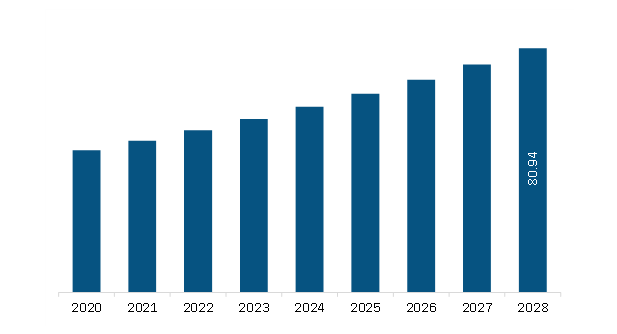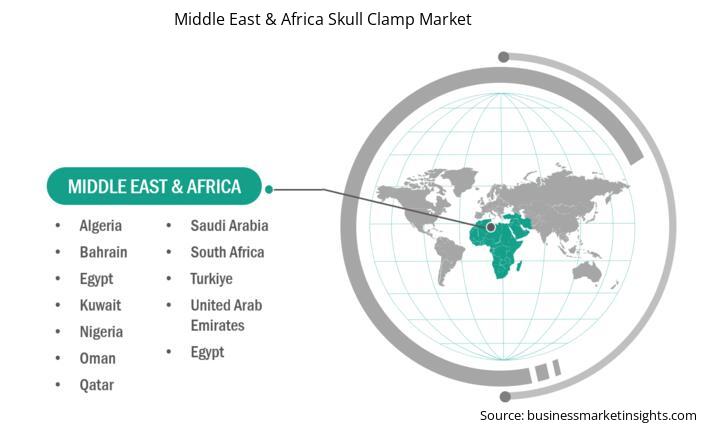Middle East & Africa Skull Clamp Market Report (2021-2031) by Scope, Segmentation, Dynamics, and Competitive Analysis
No. of Pages: 127 | Report Code: BMIRE00028790 | Category: Life Sciences
No. of Pages: 127 | Report Code: BMIRE00028790 | Category: Life Sciences
The Middle East & Africa skull clamp market size is expected to reach US$ 101.49 million by 2031 from US$ 57.46 million in 2023. The market is estimated to record a CAGR of 7.4% from 2024 to 2031.
The Middle East and Africa skull clamp market is growing steadily, driven by advancements in neurosurgery, increasing healthcare investments, and a rising incidence of neurological disorders. Key regions such as the Gulf Cooperation Council (GCC) countries, including Saudi Arabia, UAE, and Qatar, are witnessing significant growth due to their expanding healthcare infrastructure and high demand for advanced medical technologies. The increasing number of surgeries requiring precise head stabilization, including minimally invasive procedures, is further fueling the market. In addition, medical tourism in countries like the UAE is also contributing to the market's growth as patients seek high-quality healthcare. Manufacturers are focusing on innovations in skull clamp design, prioritizing lightweight, ergonomic, and durable features for improved patient comfort and safety during procedures. With healthcare development initiatives and rising awareness about advanced medical equipment, the Middle East and Africa skull clamp market is poised for further growth in the coming years.

Key segments that contributed to the derivation of the skull clamp market analysis are product, application, material, accessories, and end user.
Brain conditions are complex to identify, and ~20% of patients remain unaware of their symptoms. The use of robotics is becoming increasingly prevalent in abdominal surgery. The technology is further being explored for its potential use in minimally invasive brain surgeries. Robotic surgeries allow surgeons to perform complicated procedures with more ease, precision, and control as compared to traditional ones. In addition, there is an increasing emphasis on minimally invasive surgeries and a focus on improving surgical outcomes, which drives traction toward robot-assisted surgeries. Robots allow surgeons to venture deep into the brain through tiny incisions. Several government authorities and organizations are offering financial aid and platforms for researchers to improve the landscape of brain diagnosis and treatment. The companies are also focused on encouraging the adoption of advanced technologies, such as robotics, in neurosurgeries through research and development activities.
The American Stroke Association's International Stroke Conference 2020 emphasized using robots to treat brain aneurysms, as they could improve the accuracy of surgeries. Further, WPI Automation and Interventional Medicine Laboratory have developed a steady hand-guided aneurysm clip applier. It can provide high-precision motion while allowing neurosurgeons to maintain contact with a surgical instrument. Force sensors are incorporated between the instrument and the robot; surgeons use force to guide the movement of connected robots. Force scaling, tremor reduction, and virtual fixtures are a few features of robotic surgeries that enhance control in surgeries. This aneurysm clip applier system was presented at the CNS Conference in Denver, Colorado, where it received good feedback from participants.
The acceptance of robotic techniques for treating brain diseases is expected to increase due to their ability to improve overall performance with high accuracy, greater flexibility, and accelerated recovery. Furthermore, the techniques are expected to streamline processes and workflows, along with improving patient experience and delivering superior surgical outcomes. Thus, advancements in robotics are likely to bring new trends to neurosurgery, which would positively impact the skull clamp market in the coming years.
Based on country, the Middle East & Africa skull clamp market comprises Saudi Arabia, South Africa, the UAE, and the Rest of Middle East & Africa. Saudi Arabia held the largest share in 2023.
The healthcare system in Saudi Arabia is developing rapidly as an increasing number of sponsors are forming medical and research teams. However, in Saudi Arabia, the research regarding the incidence, prevalence, and socio-demographic properties of stroke is still inadequate compared to the developed countries worldwide. The lack of awareness is due to fewer studies in this medical subsector. The services and facilities for stroke care are considerably limited, with only ten trained stroke neurologists. Recently, changing healthcare infrastructure and public-private partnerships between government and international players are strengthening the healthcare industry in the country. Public-private collaboration and privatization is one of the policies from "Vision 2030" Saudi government strategy for transforming the economy.
| Report Attribute | Details |
|---|---|
| Market size in 2023 | US$ 57.46 Million |
| Market Size by 2031 | US$ 101.49 Million |
| CAGR (2024 - 2031) | 7.4% |
| Historical Data | 2021-2022 |
| Forecast period | 2024-2031 |
| Segments Covered |
By Product
|
| Regions and Countries Covered | Middle East and Africa
|
| Market leaders and key company profiles |
|
Some of the key players operating in the market include Black Forest Medical Group, Integra LifeSciences Holdings Corp, TeDan Surgical Innovations, Barrfab Industria Commerce Import and Export of Hospital Equipment Ltda, Herbert Thailand Co Ltd, Medifa GmbH & Co KG, Micromar Industria e Com Ltda, Schaerer Medical AG, Becton Dickinson and Co, and Baxter International Inc among others. These players are adopting various strategies such as expansion, product innovation, and mergers and acquisitions to provide innovative products to their consumers and increase their market share.
The following methodology has been followed for the collection and analysis of data presented in this report:
The research process begins with comprehensive secondary research, utilizing both internal and external sources to gather qualitative and quantitative data for each market. Commonly referenced secondary research sources include, but are not limited to:
Note: All financial data included in the Company Profiles section has been standardized to USD. For companies reporting in other currencies, figures have been converted to USD using the relevant exchange rates for the corresponding year.
The Insight Partners’ conducts a significant number of primary interviews each year with industry stakeholders and experts to validate its data analysis, and gain valuable insights. These research interviews are designed to:
Primary research is conducted via email interactions and telephone interviews, encompassing various markets, categories, segments, and sub-segments across different regions. Participants typically include:

The Middle East & Africa Skull Clamp Market is valued at US$ 57.46 Million in 2023, it is projected to reach US$ 101.49 Million by 2031.
As per our report Middle East & Africa Skull Clamp Market, the market size is valued at US$ 57.46 Million in 2023, projecting it to reach US$ 101.49 Million by 2031. This translates to a CAGR of approximately 7.4% during the forecast period.
The Middle East & Africa Skull Clamp Market report typically cover these key segments-
The historic period, base year, and forecast period can vary slightly depending on the specific market research report. However, for the Middle East & Africa Skull Clamp Market report:
The Middle East & Africa Skull Clamp Market is populated by several key players, each contributing to its growth and innovation. Some of the major players include:
The Middle East & Africa Skull Clamp Market report is valuable for diverse stakeholders, including:
Essentially, anyone involved in or considering involvement in the Middle East & Africa Skull Clamp Market value chain can benefit from the information contained in a comprehensive market report.